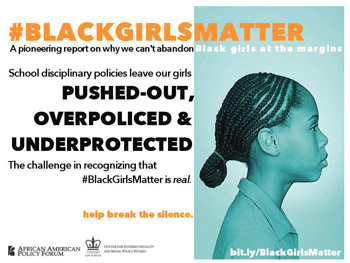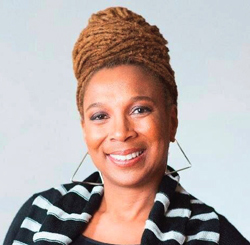Report: Black Girls Should Matter, Too
By George E. Curry -NNPA Newswire- | Last updated: Feb 16, 2015 - 11:21:55 AMWhat's your opinion on this article?

|
The report, titled “Black Girls Matter: Pushed-Out, Overpoliced and Underprotected,” was released Feb. 4. A copy of the report was obtained in advance by the National Newspaper Publishers Association News Service.

‘Black Girls Matter’ report cover
|
Anyone who doubts that Black girls are being severely disciplined for minor infractions in school need to look no further than reporting in their local media to learn otherwise, according to the report.
The report noted:
“In 2007, a 6-year-old girl was arrested in a Florida classroom for having a tantrum. Later that year, a 16-year-old girl was arrested in a California school for dropping cake on the floor and failing to pick it up to a school officer’s satisfaction.
“In 2013, an 8-year-old girl in Illinois was arrested for acting out, and a 16-year-old girl in Alabama who suffers from diabetes, asthma, and sleep apnea was hit with a book by her teacher after she fell asleep reading The Adventures of Huckleberry Finn in class. The student was later arrested and hospitalized due to injuries caused by violent interactions with the police. Also in 2013, in Florida, a 16-year-old was arrested when her ‘science experiment’ caused a small explosion in her classroom and a 12-year-old girl was threatened with expulsion from an Orlando private school unless she changed the look of her natural hair.
“In 2014, a 12-year-old girl faced expulsion and criminal charges after writing ‘hi’ on a locker room wall of her Georgia middle school, and a Detroit honor student was suspended for the entire senior year for accidently bringing a pocketknife to a football game.”

African American Policy Forum Executive Director Kimberlé Crenshaw
|
“While boys receive more than two out of three suspensions, Black girls are suspended at higher rates (12 percent) than girls of any other race or ethnicity and most boys.”
In addition, “Black students represent 16 percent of student enrollment, 27 percent of students referred to law enforcement, and 31 percent of students subjected to a school-related arrest. In comparison, White students represent 51 percent of students enrolled, 41 percent of referrals to law enforcement, and 39 percent of those subjected to school-related arrests.”
That disproportionate pattern begins at an early age.
Black children represent 18 percent of preschool enrollment but 48 percent of preschool children receiving more than one out of school suspension. On the other hand, White students represented 43 percent of preschool enrollment but only 26 percent of preschool children receiving more than one out of school suspension, according to the Department of Education.
The African American Policy Forum report grew out of a 2012 conference it convened on girls of color at the UCLA Law School.
“Girls have rarely been included in either the discussions about exclusionary disciplinary policies or the broader concerns about the underachievement of youth of color,” the report stated. “Yet the data suggest that Black girls face a variety of factors—historical, institutional, and social—that heighten their risk of underachievement and detachment from school, as well as the lifelong consequences of dropping out.”
It explained, “Research and public policy debates, however, often fail to paint a nuanced picture that addresses the degree to which girls are vulnerable to many of the same factors faced by their male counterparts. For example, reports about zero-tolerance and push-out policies frequently fail to disaggregate or highlight the consequences of such policies for girls of color. Available information about the challenges that they face in regards to suspension, expulsion, and other disciplinary practices often go underreported, leading to the incorrect inference that their futures are not also at risk.”
Among the report’s observations:
• At-risk young women say that in zero-tolerance schools, discipline receives a higher priority than educational attainment;
• Increased levels of law enforcement and security personnel sometimes make girls feel less safe and therefore less likely to attend school;
• Black girls sometimes get attention than males because they are perceived as more socially mature and self-reliant;
• Conflicts better addressed through counseling are too frequently referred to the juvenile justice system;
• Failure of schools to intervene in instances of physical or sexual harassment of girls contributes to their insecurity at school;
• Girls sometimes resort to “acting out” when their counseling needs are overlooked or disregarded;
• School-age Black girls experience a high incidence of personal violence;
• Girls are often burdened with family obligations that undermine their capacity to achieve their goals and
• Pregnancy and parenting make it difficult for girls to engage fully in school.
Recommendations included providing funding programs that serve the needs of women and girls as well as men and boys; reducing the overreliance on punitive interventions; create an environment where students are free of sexual harassment; devise programs that help identify and assist students who have been sexually victimized or traumatized by violence; offer support programs for pregnant girls or mothers with young children and mobilize the public to help address the challenges facing young girls.
Authors of the report funded by the Schott Foundation stated, “This modest but long-overdue effort to cast light onto the lives of marginalized girls should be replicated and expanded across the nation.
Ideally, the conversation ‘Black Girls Matter: Pushed Out, Overpoliced, and Underprotected’ engenders within communities and among philanthropists, policymakers, stakeholders, and advocates will lead to the inclusion of girls in efforts to address school discipline, pushout, and the pathways to incarceration, poverty, and low-wage work. We are hopeful that ongoing efforts to resolve the crisis facing boys of color will open up opportunities to examine the challenges facing their female counterparts.”
INSIDE STORIES AND REVIEWS
-
-
About Harriett ... and the Negro Hollywood Road Show
By Rabiah Muhammad, Guest Columnist » Full Story -
Skepticism greets Jay-Z, NFL talk of inspiring change
By Bryan 18X Crawford and Richard B. Muhammad The Final Call Newspaper @TheFinalCall » Full Story -
The painful problem of Black girls and suicide
By Charlene Muhammad -National Correspondent- » Full Story -
Exploitation of Innocence - Report: Perceptions, policies hurting Black girls
By Charlene Muhammad -National Correspondent- » Full Story -
Big Ballin: Big ideas fuel a father’s Big Baller Brand and brash business sense
By Bryan Crawford -Contributing Writer- » Full Story






 Click Here Stay Connected!
Click Here Stay Connected!








